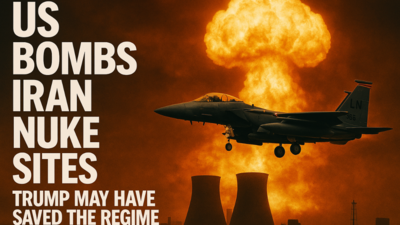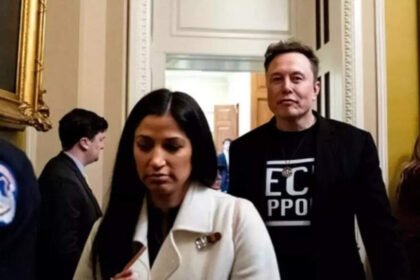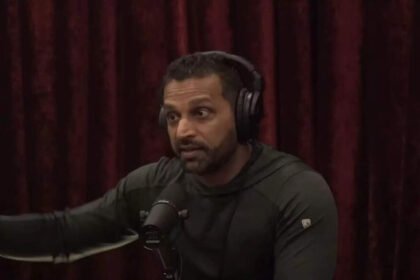At 2:00am Tehran time, American B-2 bombers unleashed the most direct attack on Iran since the Islamic Republic was founded in 1979. Three nuclear sites-Fordo, Natanz, and Isfahan-were pummeled with over 75 precision-guided munitions and Tomahawk missiles in a campaign US President Donald Trump claimed “completely and totally obliterated” Iran’s nuclear infrastructure.But the impact wasn’t only military. It was psychological. It was political. And it was, perhaps, paradoxical.Why it mattersTrump’s dramatic decision to bomb Iran’s nuclear facilities may have delivered a powerful message to Tehran but also an unintended gift: strengthening Supreme Leader Ayatollah Ali Khamenei and his regime that was increasingly isolated, domestically unpopular, and weakened by years of internal dissent.Trump’s move, aimed at crushing Iran’s nuclear ambitions and demonstrating American might, also reshaped the internal dynamics of the Islamic Republic. In the face of foreign aggression, even Iranians who oppose the regime found themselves rallying behind the flag – handing Khamenei a rare nationalist boost at a time of political fragility.A group of prominent Iranian civil society figures – long-time critics of the regime – condemned the attacks, calling them “detrimental to the human rights and democracy-seeking efforts of Iranian civil society.”The big picture
- The US military, led by B-2 bombers and Tomahawk missiles, struck three major Iranian nuclear facilities:
Fordo , Natanz, and Isfahan. These facilities were at the heart of Iran’s uranium enrichment program. - Trump declared “monumental damage” to the sites, writing on Truth Social that the deepest damage occurred “far below ground level. Bullseye!!!”
- Israel followed up with its own barrage, including strikes on missile sites and suspected command centers in Tehran, Kermanshah, and Bushehr.
- But satellite imagery and expert assessments tell a more complicated story: while Iran’s nuclear infrastructure took a hit, much of its enriched uranium and centrifuges may have been relocated ahead of the attack.
The road to FordoThe nuclear facility at Fordo was built deep in a mountain, out of reach of most conventional weapons-except America’s 30,000-pound bunker-buster bombs. Trump deployed them for the first time in combat, declaring the target a “bullseye.” Satellite imagery showed gaping craters at the site.But what about what was inside?Iranian officials, including those from the Atomic Energy Organization, claimed their most enriched uranium had already been moved. Intelligence experts can’t confirm the extent of underground damage, and some believe Iran’s nuclear assets are now more dispersed-and harder to target-than ever. “This is an incomplete strike,” Jeffrey Lewis, a weapons expert and professor at the Middlebury Institute of International Studies, told AP. “If this is all there is, here’s what’s left: the entire stockpile of 60% uranium, which was stored at Isfahan in tunnels that are untouched,” Lewis added.What they’re saying
- “Mr Trump, the gambler, you may start this war, but we will be the ones to end it,” declared Iranian military spokesman Ebrahim Zolfaqari.
- Trump doubled down on social media: “If the current
Iranian Regime is unable to MAKE IRAN GREAT AGAIN, why wouldn’t there be a Regime change???” - Richard Haass, president emeritus of the Council on Foreign Relations, told CNN: “This never would have happened had they had nuclear weapons … They may now sprint toward one.”
Zoom in
- The nationalist reflex Trump triggered is deeply rooted in Iran’s modern history. Since the CIA-backed coup in 1953 that toppled a democratically elected government, suspicion of foreign interference – especially from the US – has been a defining theme in Iranian politics.
- Even during the recent mass protests against the clerical regime, few demonstrators called for Western intervention. That ethos flared again after the strikes. A mural in Tehran was repainted recently: the American flag, with stars replaced by skulls and stripes as falling bombs, towers over a main boulevard. The “Death to America” slogan remains etched into public spaces.
- The result: a regime many Iranians despise was suddenly able to posture as the protector of the nation.
Between the linesThere’s a profound irony in the timing. Before the attack, Tehran’s regime faced growing unrest. The once-vibrant reform movement had long since faltered. Crackdowns on protests in cities and small towns had turned many Iranians against their rulers. Trust in the ballot box was gone. Ayatollah Khamenei – aging and reportedly nominating his own successors – was presiding over a brittle system.But by launching military strikes on Iranian soil, the US – and Israel – allowed the Islamic Republic to reclaim a narrative it had lost: that of resisting imperial aggression.This sentiment is not just theoretical. In practice, it has meant increased government control, tighter censorship, and the silencing of opposition voices – now easier to justify under the guise of national defense.The intrigueThe attack has sparked geopolitical ripple effects far beyond Iran:
- Russia: Hosting Iranian officials, Moscow warned of “Pandora’s box” being opened by US aggression.
- The UN: Secretary-General António Guterres feared a “rathole of retaliation.”
- Global oil markets: Prices surged to their highest levels since January amid fears of wider conflict.
What Trump wanted vs. what he got:Trump aimed to eliminate Iran’s nuclear capability, deter future threats, and perhaps even force a regime change. He invoked strength, promising peace through overwhelming power.But what he may have achievedReigniting anti-American fervor inside Iran.Rallying Iranians around a regime they otherwise loathed.Escalating a conflict that could outlast his presidency – and potentially ensnare the US in another Middle East quagmire.Vice President JD Vance tried to reassure Americans that the US does not seek regime change. But Trump undercut that message himself, posting: “Why wouldn’t there be a Regime change???”What’s nextIran’s next steps could define the region’s future – and Trump’s legacy.The regime’s military options:
- Missile retaliation: Already underway with strikes on Tel Aviv and threats against US bases.
- Strait of Hormuz closure: Iran could throttle one-fifth of the world’s oil supply, sparking a global crisis.
- Proxy attacks: From Lebanon to Yemen, Iran’s network of allies could be activated, though many have been degraded by Israel’s recent offensives.
But there’s another, quieter possibility: a dash to the bomb. Experts fear that humiliation on the global stage may convince Iranian leaders that only a nuclear deterrent can ensure their survival.Darya Dolzikova, a nonproliferation expert at the Royal United Services Institute, warned that Iran may have “already moved” critical nuclear materials to unknown sites. The IAEA has yet to inspect the bombed facilities to confirm the extent of the damage.The bottom lineTrump’s strikes may have damaged centrifuges, but they didn’t decapitate the Iranian regime. Instead, they may have reinvigorated it – uniting a fractured society against a common foreign enemy and setting the stage for a prolonged and dangerous confrontation.(With inputs from agencies)






